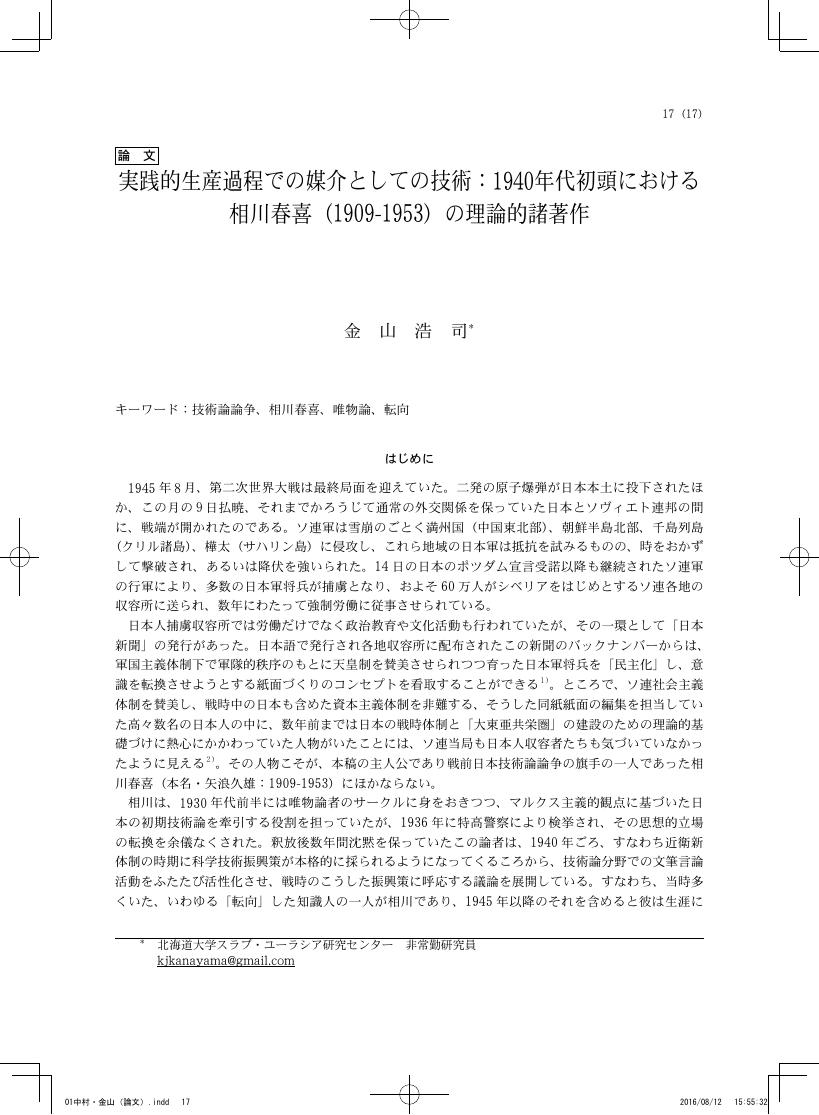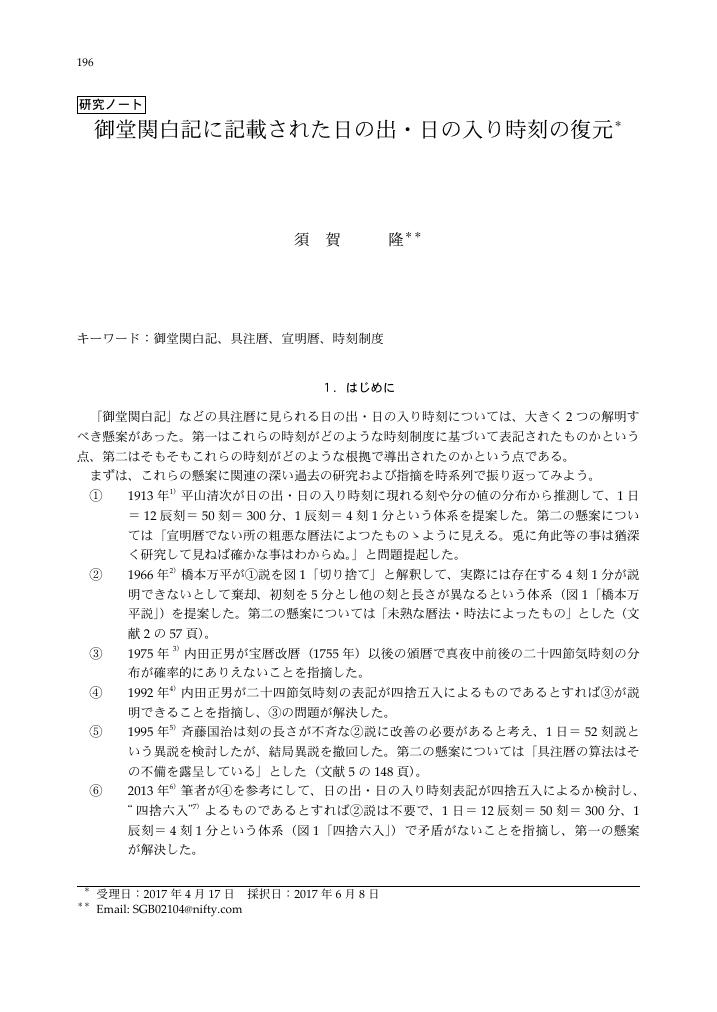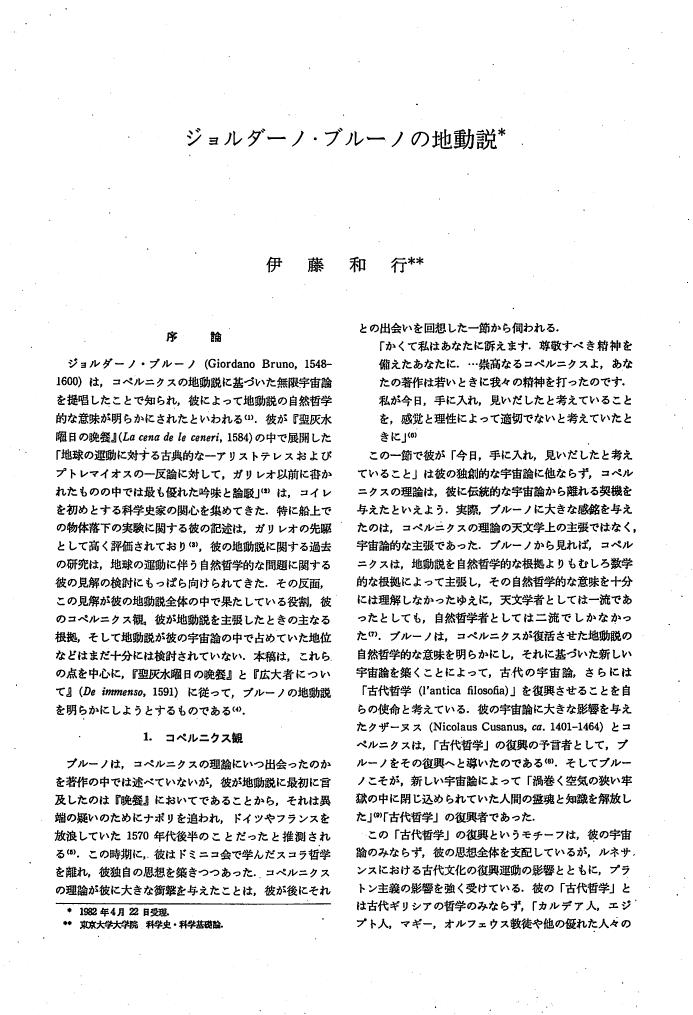7 0 0 0 OA Lichenは如何にして地衣と翻訳されたか
- 著者
- 久保 輝幸
- 出版者
- 日本科学史学会
- 雑誌
- 科学史研究 (ISSN:21887535)
- 巻号頁・発行日
- vol.48, no.249, pp.1-10, 2009 (Released:2021-08-04)
Chii, the Japanese term for 'lichen', is widely used in contemporary East Asia. However, precisely when and by whom this term was first used to refer to lichen is not known. In addition, Japanese botanists from the 1880s to the 1950s had doubts regarding whether Chii was an accurate translation of lichen, given that Chii originally referred to moss that grows on the ground, whereas most species of lichens grow on barks of trees or on rocks. In this paper, the author shows that Li Shanlan and A. Williamson et al., in the late Qing dynasty of China, first used the term Chii to refer to lichen in Zhiwuxue, published in 1858. In Japan, Tanaka Yoshio, who was influenced by Zhiwuxue, first used the term Chii in 1872. However, further investigations led to the discovery that ITO Keisuke translated lichen as Risen in 1829. In 1836, UDAGA WA Yoan also translated lichen as Risen by using a different kanji (Chinese character) to represent sen. In 1888, in his article, MIYOSHI Manabu suggested a new equivalent term, Kisoukin, to refer to lichen (algae-parasitized fungi). In the article, he proposed the term Kyosei as the Japanese translation of symbiosis. Ever since the late 1880s, Kyosei has been used as the Japanese biological term for symbiosis.
6 0 0 0 OA 科学史入門:古代ローマの人口問題
- 著者
- 小林 雅夫
- 出版者
- 日本科学史学会
- 雑誌
- 科学史研究 (ISSN:21887535)
- 巻号頁・発行日
- vol.31, no.184, pp.224-227, 1992 (Released:2021-04-03)
6 0 0 0 OA ガズナ マフムードとアル•ビールーニー アラビア科学研究ノ ート-14-
- 著者
- 矢島 祐利
- 出版者
- 日本科学史学会
- 雑誌
- 科学史研究 (ISSN:21887535)
- 巻号頁・発行日
- vol.28, no.169, pp.41-45, 1989 (Released:2021-09-01)
5 0 0 0 OA 戦時期日本における結核集団検診と「既感染健康者」の生成
- 著者
- 塩野 麻子
- 出版者
- 日本科学史学会
- 雑誌
- 科学史研究 (ISSN:21887535)
- 巻号頁・発行日
- vol.61, no.302, pp.122-138, 2022 (Released:2023-11-17)
This paper examines how mass screening for tuberculosis was implemented in wartime Japan. A tuberculosis mass screening program for the entire Japanese population began with the National Physical Fitness Management System (1940). This approach reflected the latest theories in Japanese tuberculosis pathology that primary infection would develop into an active disease more frequently. Under the total war system, the mass screening program divided the population according to the status of tuberculosis infection and contraction, with a focus on the prevention of the disease in those infected for the first time. Those classified as “previously infected healthy individuals,” a term introduced for screening, were considered more desirable than the uninfected because they were supposed to have gained “immunity” to the disease after a certain period of time had passed since the primary infection. They were not only said to be the safest against tuberculosis but also as those who had overcome the danger of developing tuberculosis and acquired a strong body that could endure discipline and labor. This paper argues that the tuberculosis mass screening program emphasized the acquisition of immunity and that the new tuberculosis control system was built based on the concept of “previously infected healthy individuals.”
- 著者
- 渡邊 洋之
- 出版者
- 日本科学史学会
- 雑誌
- 科学史研究 (ISSN:21887535)
- 巻号頁・発行日
- vol.53, no.270, pp.169, 2014 (Released:2020-12-09)
This paper discusses some facts that were pivotal in the process of the introduction of Bluegill Sunfish, Lepomis macrochirus, into various places in Japan, however have not been considered in the existing literature. This paper points out that L.macrochirus escaped, and also was stocked, to the open water in Osaka as a result of experiments by a fisheries experimental station in the 1960s and early 1970s. In Shiga Prefecture too, the fish escaped into Lake Biwa as a result of experiments by a fisheries experimental station in about 1969. Neither Osaka nor Shiga are mentioned, by previous studies based on questionnaire research, as the prefectures in which L.macrochirus inhabited in the years between 1960, when the fish was first introduced into Japan, and 1979. In addition, anglers, who considered L.macrochirus an ideal game fish, stocked ponds and lakes in some prefectures with L.macrochirus in around 1970 on purpose to multiply the species. During this process, a network among not only local governments, fisheries experimental stations, and fish farmers, but also industries targeting anglers, such as fishing tackle makers and a magazine for anglers, was being formed, which however did not get established after all. These findings will contribute to enrich the basis of today's genetic research on the distribution of L.macrochirus in Japan.
5 0 0 0 OA 放射線防護とは何か--ICRP勧告の歴史と福島原発事故の教訓
- 出版者
- 日本科学史学会
- 雑誌
- 科学史研究 (ISSN:21887535)
- 巻号頁・発行日
- vol.60, no.298, pp.150-174, 2021 (Released:2022-08-01)
5 0 0 0 OA 総動員と野生生物 : 日本におけるヌートリアの移入
- 著者
- 渡邊 洋之
- 出版者
- 日本科学史学会
- 雑誌
- 科学史研究 (ISSN:21887535)
- 巻号頁・発行日
- vol.42, no.227, pp.129-139, 2003 (Released:2021-08-12)
This paper is to explain the process of the introduction of nutrias in Japan and the thoughts of various people who were related to it. Since nutrias was regarded as furred animals suitable for the wartime system and attracted the interest of the military, breeding of them was spread rapidly. However, the demand for nutrias furs was vanished by the defeat of WWII, then nutrias were ejected in the open air. At a later time, around 1950, breeding of nutrias became popular once again. But this boom was declined after several years and nutrias were ejected outdoors again because the boom did not expand beyond the stage of speculative business. This fact shows that in the historical context, the introduction and expansion of nutrias was not seen as a problem but even recommended, which is different from today's principle that any introduced species should be expelled. On the other hand, this paper can not confirm any fact showing the argument about the introduction of nutrias had some influence on the argument about what human society ought to be like. However, it shows that biologists have attempted to speak figuratively about nutrias by giving them various names, for example, shouri (this is a homonym of the word that means victory in Japanese) or rumin (this word means immigrants who are forced to wander in Japanese). This fact means that any discourse about the introduction of living things should become not only scientific but social.
5 0 0 0 岩橋家によって製作された3点の小型一閑張望遠鏡の発見
- 著者
- 株本 訓久
- 出版者
- 日本科学史学会
- 雑誌
- 科学史研究 (ISSN:21887535)
- 巻号頁・発行日
- vol.59, no.293, pp.18-37, 2020 (Released:2021-01-24)
The purpose of this paper is to identify who fabricated the three small Ikkanbari (一閑張) telescopes discovered by the author, and to estimate when these telescopes were fabricated from a historical perspective. Zenbei IWAHASHI (1756–1811) was one of the most famous Japanese telescope makers of the Edo period and fabricated many high-performance telescopes. After Zenbeiʼs death, his successors inherited his manufacturing technique and continued to fabricate Ikkanbari telescopes until the Meiji period. To date, telescopes fabricated by the IWAHASHI family have been investigated by the author, Makoto WATANABE and his colleagues, who have already identified 24 telescopes as having been fabricated by the IWAHASHI family. Most of these telescopes provided direct evidence of their origin, such as the IWAHASHI familyʼs original pattern Kuruma gata (車形), the inscription of the name IWAHASHI, and the IWAHASHI trademark. In this study, the author investigated three small Ikkanbari telescopes. There is no direct evidence that the telescopes were fabricated by the IWAHASHI family, except for one telescope that had IWAHASHI trademark on its case. However, the author concluded that a telescope can be considered as having been fabricated by the IWAHASHI family if its size is equal to that of the telescopes described in Saikutsumori-cho (『サイクツモリ□』帳) and if several of its patterns are the same as those of the telescopes known to have been fabricated by the IWAHASHI family. This result confirms M.WATANABEʼs opinion.
4 0 0 0 OA 広島・長崎の原爆放射線影響研究 -急性死・急性傷害の過小評価-
- 著者
- 中川 保雄
- 出版者
- 日本科学史学会
- 雑誌
- 科学史研究 (ISSN:21887535)
- 巻号頁・発行日
- vol.25, no.157, pp.20-33, 1986 (Released:2021-04-05)
4 0 0 0 OA 小特集 「進化論誤用・悪用・濫用」問題
- 出版者
- 日本科学史学会
- 雑誌
- 科学史研究 (ISSN:21887535)
- 巻号頁・発行日
- vol.60, no.299, pp.245, 2021 (Released:2022-08-01)
4 0 0 0 OA 資料 : イブン・アル=ハイサム『光についての論述』
- 著者
- 甲子 雅代
- 出版者
- 日本科学史学会
- 雑誌
- 科学史研究 (ISSN:21887535)
- 巻号頁・発行日
- vol.33, no.191, pp.143-151, 1994 (Released:2021-03-22)
4 0 0 0 OA 近代西洋科学用語の中日貸借対照表
- 著者
- 中山 茂
- 出版者
- 日本科学史学会
- 雑誌
- 科学史研究 (ISSN:21887535)
- 巻号頁・発行日
- vol.31, no.181, pp.1-8, 1992 (Released:2021-03-25)
- 著者
- 金山 浩司
- 出版者
- 日本科学史学会
- 雑誌
- 科学史研究 (ISSN:21887535)
- 巻号頁・発行日
- vol.54, no.273, pp.17, 2015 (Released:2020-12-14)
AIKAWA Haruki, one of the prominent theorists of technology study in Japan in the prewar period, put forward fresh philosophical understandings of technology in the first days of the 1940s. He saw the unification of the subjective humanity and objective material in the dynamic process of production and regarded technology as a medium of such unification. By investigating his books published in the period of the Konoe's New Order, present paper seeks to reveal how Aikawa acquired his own idea on technology. It also aims to put the improvement of his thought in the sociopolitical context of wartime Japan. In the first half of the 1930s, Aikawa had a materialistic view: that is, he observed that the nature of technology was represented in the means of labor in itself. Although Aikawa's idea was accepted among members of the Society for the Study of Materialism as one of the possible Marxist understandings of technology, it was also criticized for ignoring the importance of the subjective labor force in the process of production. After his arrest as a suspected communist sympathizer in 1936, Aikawa abandoned his previous standpoint and came to be a spokesman of the war policy of Imperial Japan. We should not regard this alternating process as a simple conversion under the suppression of the Japanese militarists, however. Aikawa certainly made a compromise, but at the same time, he intended to develop his idea on technology by accepting criticism by materialists. In such a process Aikawa succeeded in making his thought a more balanced one.
4 0 0 0 OA 御堂関白記に記載された日の出・日の入り時刻の復元
- 著者
- 須賀 隆
- 出版者
- 日本科学史学会
- 雑誌
- 科学史研究 (ISSN:21887535)
- 巻号頁・発行日
- vol.56, no.283, pp.4, 2017 (Released:2021-01-10)
- 著者
- 市川 浩
- 出版者
- 日本科学史学会
- 雑誌
- 科学史研究 (ISSN:21887535)
- 巻号頁・発行日
- vol.59, no.295, pp.199-213, 2020 (Released:2021-01-24)
4 0 0 0 科学普及活動家ルイ・フィギエと死後の魂をめぐる問題
- 著者
- 槙野 佳奈子
- 出版者
- 日本科学史学会
- 雑誌
- 科学史研究 (ISSN:21887535)
- 巻号頁・発行日
- vol.59, no.294, pp.99-112, 2020 (Released:2021-01-24)
4 0 0 0 共同利用研究所における自治の相克
- 著者
- 平田 光司 高岩 義信
- 出版者
- 日本科学史学会
- 雑誌
- 科学史研究 (ISSN:21887535)
- 巻号頁・発行日
- vol.59, no.293, pp.38-52, 2020 (Released:2021-01-24)
Inter-University Research Institutes (IURIs) are supposed to be shared properties of the researchers of corresponding disciplines. The Institute of Nuclear Study (INS) affiliated to the University of Tokyo was the first IURI equipped with large scientific facilities. A newly found set of records, collected and archived by Hiroo Kumagai, a former professor of INS, gives us new insights and interpretation of the history of the INS and its successors. INS was designed to be managed democratically on the sole basis of the common will of all nuclear physicists in Japan (the autonomy of the research community). It conflicted with the principle of the autonomy of the university. It is shown that the conflict of the two different kinds of autonomy was one of the motivations to create a new, larger physics institute, the Laboratory for High Energy Physics (KEK). Because of this historical background, KEK and other newer IURIs could provide “virtual” autonomy for researchers, though they are formally the institutes operated by the government.
3 0 0 0 OA 外国における"血液型パーソナリティの関係"をめぐる研究
- 著者
- 溝口 元
- 出版者
- 日本科学史学会
- 雑誌
- 科学史研究 (ISSN:21887535)
- 巻号頁・発行日
- vol.32, no.187, pp.152-156, 1993 (Released:2021-03-23)
3 0 0 0 OA ジョルダーノ・ブルーノの地動説
- 著者
- 伊藤 和行
- 出版者
- 日本科学史学会
- 雑誌
- 科学史研究 (ISSN:21887535)
- 巻号頁・発行日
- vol.21, no.142, pp.81-87, 1982 (Released:2021-05-13)














